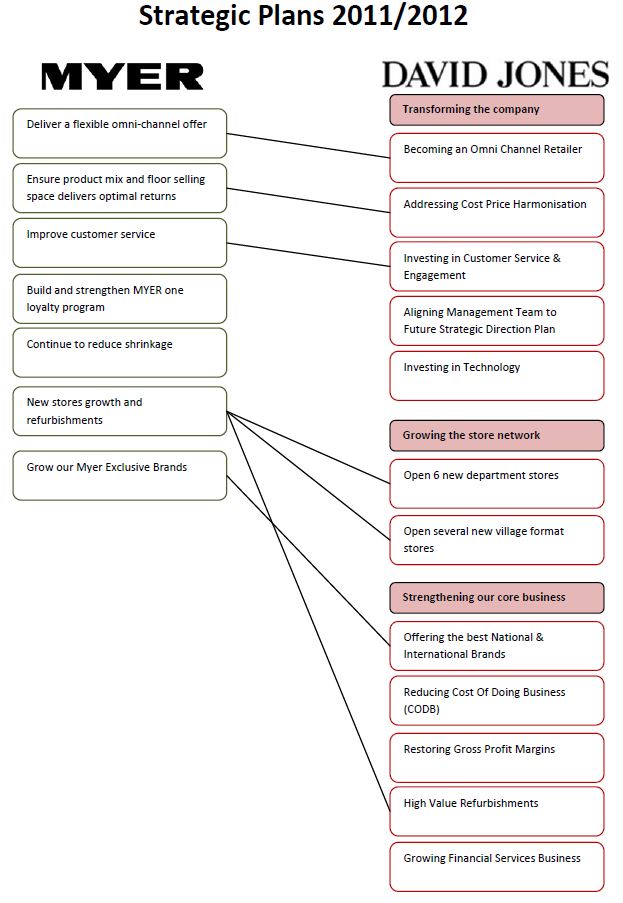Comparing strategic approaches to see what strategy looks like: Myer versus David Jones

I follow on my recent post on strategic planning with a practical question: What does strategy look like?
My focus on strategy started when I read an article in the Australian Financial Review where Bernie Brookes, the CEO of Australian department store Myer, quoted his five strategic initiatives for the future of the company. It struck me how a clear strategy makes the challenges of business become succinct and focused.
A strategy clearly outlines what you are going to do as well as what you are not going to do. This may seem like simple stuff, but a surprisingly large number of organisations do not have a strategy. To see what strategy actually looks like, it can help to compare two companies that are slightly different flavours in the same industry.
What does a Strategy look like?

Australian retailers Myer and David Jones provide a convenient case study as both have similar offerings and markets with easily understandable business models. They are also required to provide reporting to investors, making information easily accessible.
The review is based on:
- Myer 2011 Annual report
- Myer September 2012 full year results
- David Jones FY2012 September results
- David Jones March 2012 future strategic direction update
- David Jones September strategic direction plan and update
This is by no means a deep analysis nor am I a financial analyst. Rather, this is a brief review of the strategies stated by both companies to see if there are common attributes to consider when creating strategy for other organisations.
For example, it appears to be important to limit the…
Number of strategies
The number of strategic initiatives needs to be enough to cover the broad spectrum of the business without being overwhelming. Myer presents it strategy in seven areas, whereas David Jones lists twelve initiatives in three categories. There are obviously several strategic initiatives under each statement. It is easier, however, to rally behind five areas of focus rather than keeping in mind thirty priorities. This may mean a few pet projects are not included, and also requires a balance between…
Detail versus generality
Strategies that are general can encompass several initiatives, but if too vague can lack accountability and effectiveness. Myer plans for “new stores growth and refurbishments” while David Jones will “open six new department stores”. Listing specifics in a strategic statement can be good to rally the troops and contain the target, but it can also limit initiative and introduce unnecessary risk of a visible recant if the target is not hit. What is and is not included can be based on the degree of…
Strategy overlap
Decisions need to be made whether a strategy stands on its own or whether it is part of a wider strategy. David Jones is intent on “becoming an omni channel retailer” while the company is also “investing in technology”. I would assume technology investment is assumed in Myer’s strategy to “deliver a flexible omni-channel offer”. Some organisations group strategies into priority areas, as is the case with David Jones, while others may create sub-strategies. The impact of these strategies can be based on the use of…
The action verb
A strategy typically involves a powerful action verb. Myer and David Jones commit to grow, build, improve, deliver, reduce, become, invest, align, open, and restore aspects of their business. Other verbs not as compelling include ensure, address, and offer. The way the strategy is written can be compelling and helps the direction of the company to be…
Understood by everyone
Strategies can be written in the newspaper, posted online, announced at staff meetings, delivered to investors, and shared in client presentations. Strategies will be interpreted differently to various stakeholder groups, but the underlying meaning will be consistent. Both Myer and David Jones feel it is more important to cast a strong strategic direction than risk the other discovering any strategic secrets. On the contrary, a comparison between each organisation’s strategies shows similar approaches.
The comparison
Both Myer and David Jones operate in a similar context, so it would make sense they would have very similar strategies. To use a sporting metaphor, two runners may have similar strategies to win a race, but one may focus on strength and the other on breathing.
Both department stores focus on costs through appropriate product mix, although Myer’s statement to “ensure product mix and floor selling space delivers optimal returns” has a more positive spin. Both companies will focus on customer service and store growth. Both companies have latched onto the concept of being “omni channel” (as compared to multi-channel as referenced by similar companies in the US such as Nordstrom and Sears).
The difference between the strategies is in the detail and in what is not mentioned. Myer is in a position to “grow our Myer Exclusive brands”, which was at 50 at 2011 reporting time complementing the other 2,400 brands for a “whole of home” solution. David Jones does not stipulate the total number of brands in 2011 apart from adding 90 brands for a “Home of Brands” strategy supported by the strategy to “offer the best National & International brands”. It is this “Home of Brands” strategy it articulates as the primary differentiator.
Strategy is measured by outcomes, which are typically financial in nature in our commercial world. Myer makes a note of saying they are the largest, pulling in total sales over $3.1 billion to David Jones’ $1.9 billion. Size does not always matter, however, with David Jones reporting a higher earnings before income and tax (EBIT) margin of 8.26 percent compared to Myer’s 7.37 percent.
Immediate returns are not always an indicator of strategy success, depending on whether the strategy is designed to have short or long-term impacts. As Myer CEO Brooks says in response to a drop in share price: “If we hadn’t invested in customer service, we would have lost our customer franchise and exposed ourselves even more to the world wide web. We had to take our medicine and balance that against the long term view.”
Who does strategy?
Strategy is a key consideration for both companies. The word strategy or strategic is mentioned 50 times in David Jones’ 2011 annual report, 51 times in Myer’s. Both annual reports are very clear as to who takes responsibility for strategy in the organisation. This is important to understand when assigning ownership and accountability in the structure of your organisation.
Myer notes the Executive General Manager is responsible for the development of Myer‘s strategic planning framework, as well as all aspects of human resources. Other executive roles are responsible for functional-specific aspects of strategy, such as the Executive General Manager Stores for delivery of operational strategies and the Group General Manager Marketing and Brand Development for the brand strategy responsibility.
Myer’s CEO relies on others to provide the strategy framework as well as the execution of strategy in their areas of speciality. David Jones distributes the responsibility across the Executive Committee to implement group policy, manage corporate processes and review strategy and resources. Clear lines of ownership and accountability are critical.
Both organisations also clearly define the relationship between the board and the CEO. The Board has a responsibility to:
- to monitor corporate performance and the implementation of strategy and policy (Myer)
- to contribute to and approve management development of corporate strategy, including setting performance objectives and approving operating budgets (Myer)
- review and approve the annual budget and strategic plan (David Jones)
- review and approve the strategic allocation of capital including major capital projects and property leases (David Jones)
The Board is ultimately responsible for identifying and assessing internal and external risks that may impact the Company in achieving its strategic objectives. The Board then delegates the implementation of the strategic objectives, plans and budgets approved by the Board to the CEO and management.
The CEO is then responsible for:
- implementing strategic objectives, plans and budgets approved by the Board (Myer)
- managing in accordance with the strategy, plans and delegations approved by the Board (David Jones)
The approach to strategy, the strategy itself, and the delivery of strategy can be performed by leadership team. The Board is responsible for the outcomes of the strategy and the CEO is responsible for ensuring the strategy is implemented. The CEO is also accountable for ensuring a strategy exists and that her or his actions align with that strategy.
An academic case study with practical application
A comparison between the strategies of Myer and David Jones confirms in part what strategy looks like and who is responsible within an organisation. I respect the target audience of this post is limited to those in a similar role to my current gig where there is a need to clarify, define, and execute strategy.
If this is you and it helped or if there are other observations to be made, drop me a comment or like below. If this is not you, then you probably didn’t get this far down the post, so all good. Either way, I trust your response will be part of your well-defined strategy.


I now have this strange compulsion to eat fruit.
Choice customer service survey skewers department stores, major retailers
http://www.smartcompany.com.au/retail/052037-choice-customer-service-survey-skewers-department-stores-major-retailers.html?utm_source=SmartCompany&utm_campaign=1b5f017cef-Wednesday_6_September_201206_09_2012&utm_medium=email